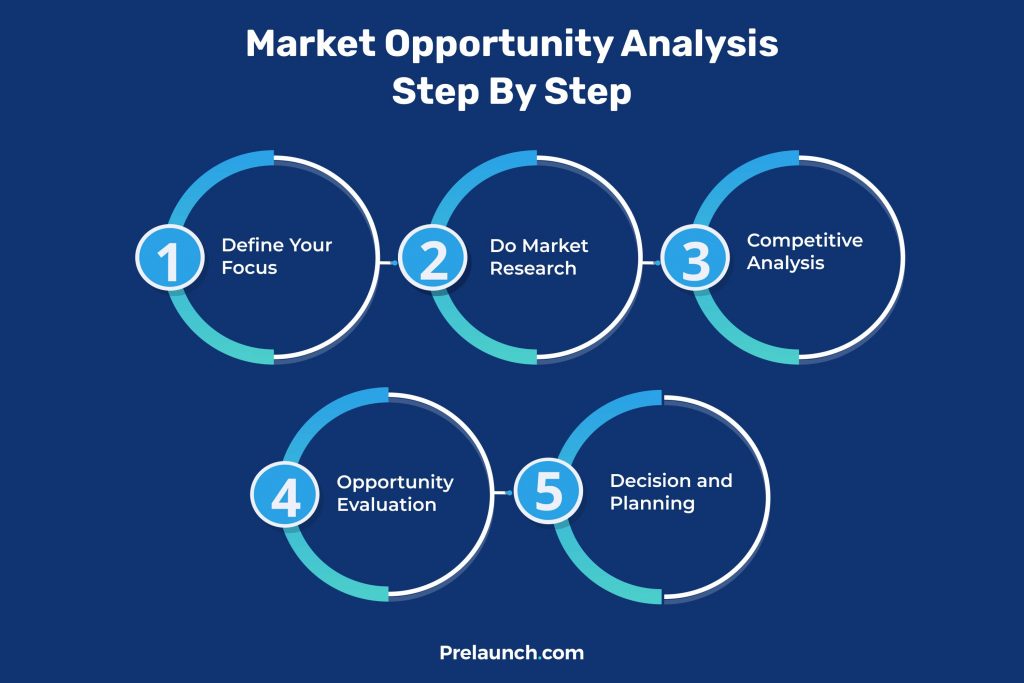In entrepreneurship, recognizing and capitalizing on market opportunities is like striking gold. Market opportunity analysis is the thorough dissection of market conditions and trends to unveil prospects that align with the growth and direction of your business. For entrepreneurs, startups, and small business owners, conducting a meticulous market opportunity analysis could be the difference between success and stagnation.
What is a Market Opportunity?
Before venturing into the steps of analysis, understanding the term “market opportunity” is imperative. A market opportunity is essentially a sweet spot in the business world where a need or want exists among consumers, and there’s an opening for a company to fill that gap. It’s a chance to capitalize on a situation where there’s potential for profit by providing a product or service that clicks with the target market.
This is what a market opportunity entails:
Unmet Needs or Wants: At the core, it boils down to identifying something that people desire but aren’t necessarily getting from current offerings in the market. This could be a completely new need arising from technological advancements or a gap in existing products or services that leaves consumers feeling unsatisfied.
Profitable Potential: There should be a sizable group of people willing to pay for the solution you’re proposing. The size of the market and the willingness to spend are crucial factors in determining the overall appeal of the opportunity.
Addressing the Gap: A market opportunity isn’t just about identifying a need; it’s about offering a solution that stands out. This could involve creating a completely new product category, significantly improving upon existing options, or tailoring something to a specific niche audience that feels neglected.
These are the broad avenues by which market opportunities can be spotted:
Market Research: Conducting thorough research to understand consumer trends, competitor analysis, and overall market sentiment can reveal gaps that your business idea can address.
Analyzing Customer Behavior: How people interact with products and services can provide clues about what they find frustrating or lacking. Look for ways to streamline processes or add features that enhance the customer experience.
Innovation and Invention: Sometimes, the most lucrative opportunities lie in creating entirely new categories or disrupting existing markets with groundbreaking ideas.
Considering Broader Trends: Major shifts in society, technology, or environmental concerns can open doors for innovative solutions. Think about how your product or service can address these emerging needs.
By identifying and capitalizing on market opportunities, businesses can achieve growth, expand their market share, and establish themselves as leaders in their respective fields.
Factors Influencing Market Opportunity
The landscape of a market opportunity is shaped by a complex interplay of various factors. There are several key factors that contribute to an opportunity’s attractiveness.
Market Dynamics:
- Supply and Demand: This fundamental principle dictates the overall attractiveness of an opportunity. A strong market opportunity thrives on a healthy imbalance between unmet demand and readily available solutions. If there’s a limited market for your offering or if existing players effectively fulfill the need, the opportunity might be less promising.
- Competition: The competitive landscape significantly impacts an opportunity. A market dominated by a few strong players makes it challenging for new entrants. However, an opportunity might still exist if you can offer a differentiated product, target a niche market, or disrupt the current model altogether.
- Market Size and Growth: The size of the target market, along with its projected growth, determines the potential revenue and scalability of your venture. Targeting a large and growing market with your solution offers a wider audience and a more sustainable business model.
External Factors:
- Economic Conditions: Overall economic health plays a big role. During economic booms, consumers have more disposable income, making them more receptive to new products and services. Conversely, economic downturns can lead to cautious spending, hindering the success of new market entries.
- Technological Advancements: Technological disruptions can create entirely new market opportunities or reshape existing ones. Staying on top of technological trends allows you to leverage advancements to create innovative solutions or improve existing ones.
- Sociocultural Trends: Shifts in demographics, societal values, and lifestyles can open doors for businesses that cater to these evolving preferences. Understanding these trends allows you to tailor your product or service to resonate with the changing consumer landscape.
- Political and Legal Environment: Government policies, regulations, and legal frameworks can influence the viability of a market opportunity. Ensure there are no legal roadblocks or unexpected costs associated with entering the market due to regulations.
- Environmental Considerations: Sustainability concerns are becoming increasingly important. A market opportunity that offers eco-friendly solutions or caters to the growing demand for responsible business practices can be highly attractive.
Additional Considerations:
Industry Trends: Understanding the specific trends within your target industry can reveal emerging opportunities or areas ripe for disruption.
Customer Pain Points: Identifying the frustrations and challenges faced by potential customers allows you to craft solutions that directly address their needs.
Understanding and leveraging these factors to identify and act upon market opportunities can be the key catalyst for successful business innovation, setting the stage for the next critical steps in developing a strategic business plan.
Benefits of Market Opportunity Analysis
A market opportunity analysis is a crucial step for any business looking to thrive. It’s essentially a deep dive into the potential of a market opportunity, analyzing its viability and weighing the pros and cons before committing resources. Here’s why a market opportunity assessment is so important:
Informed Decision Making
Without a thorough assessment, you’re essentially gambling on the success of your venture. The assessment provides valuable data and insights that illuminate the potential risks and rewards associated with the opportunity. This allows you to make strategic decisions based on facts and figures, not hunches.
Reduced Risk
By pinpointing potential challenges and roadblocks early on, you can take steps to mitigate risks or even pivot to a more promising opportunity. Early detection is key to avoiding costly mistakes and wasted resources.
Optimized Resource Allocation
Resources, such as time, money, and personnel, are finite. The assessment helps you allocate resources effectively by highlighting areas that require the most focus and investment. You can prioritize efforts where they’ll have the biggest impact.
Identifying Unmet Needs
A well-conducted assessment goes beyond surface-level analysis. It helps you unearth deeper customer needs that aren’t being fully addressed by existing solutions. This allows you to tailor your product or service for a more targeted and impactful approach.
Competitive Advantage
The assessment process reveals your competitor landscape. You can identify their strengths and weaknesses, allowing you to develop a differentiated offering that stands out in the market.
Customer Focus
By understanding your target market intimately through the assessment, you can ensure your product or service resonates with their needs and preferences. This customer-centric approach is essential for building a loyal customer base.
Financial Projections
The assessment helps you develop realistic financial projections based on market size, pricing strategy, and potential sales volume. This allows you to make informed decisions about funding requirements, profitability, and potential return on investment (ROI).
Stronger Business Plan
The findings from the assessment feed directly into the creation of a robust business plan. This plan, grounded in solid market research and data, becomes a roadmap for your business growth and success.
Investor Confidence
If you’re seeking investment, a market opportunity assessment demonstrates your due diligence and understanding of the market landscape. This instills confidence in investors and increases the likelihood of securing funding.
Market Opportunity Analysis Process Step by Step
Use this market opportunity analysis template for your next endeavor to streamline and systematize the process:
Step 1: Define Your Focus
Imagine you’re a company that makes fitness trackers. You see a potential rise in demand for wearable health monitors. Here’s how to define your scope:
- Identify Market Opportunities: Brainstorm possibilities within the wearables market. Maybe it’s a fitness tracker for kids or one focused on sleep monitoring.
- Choose Your Focus: Pick a specific opportunity to delve deeper into, like a sleep-oriented tracker. This will guide your research.
Step 2: Dive into Market Research
- Gather Data: Look for a mix of primary and secondary sources. Conduct surveys or interview potential customers (primary). Gather market reports and industry publications (secondary).
- Market Landscape: Find the size of the target market (people with sleep issues interested in trackers) and its growth projections. Look for trends like the growing interest in personalized health data.
- Customer Needs and Pain Points: What are people’s sleep concerns? Do existing trackers address them effectively? Maybe they lack user-friendly interfaces or in-depth sleep analysis.
Step 3: Analyze the Competition
- Who are the Competitors? Identify companies offering sleep trackers or similar wearables targeting sleep issues.
- Competitive Landscape: Research their strengths (reliable data, long battery life) and weaknesses (complex setup, generic insights). Analyze their marketing strategies and target audience.
- Your Competitive Edge: Can you offer a tracker with a user-friendly app and detailed sleep stage monitoring, differentiating yourself from competitors?
Step 4: Market Evaluation
- Market Attractiveness: Is the sleep tracker market big enough with room for growth? Is there a strong customer base willing to pay for such a device?
- Business Alignment: Does this opportunity align with your company’s expertise in wearable technology and focus on health?
- Resource Requirements: Consider the resources needed – developing the tracker, designing the app, and potentially new manufacturing processes.
Step 5: Decision and Planning
- Go or No-Go: Based on your research, decide if this sleep tracker opportunity is worth pursuing. Weigh the potential risks (high development costs, competition) and rewards (capturing a new market segment).
- Market Entry Strategy: If you decide to move forward, create a plan. This includes your tracker’s features, pricing strategy, target audience for marketing, and how you’ll manufacture and distribute the device.
Remember, It’s Ongoing!
The market is constantly changing. Regularly revisit your analysis to ensure your strategies remain relevant as the sleep tracker market and customer preferences evolve.
Market Opportunity Analysis Example
Scenario: Imagine you’re a company specializing in plant-based milk alternatives (e.g., soy milk, almond milk). You’ve observed a rise in consumer interest in plant-based diets and wonder if there’s an opportunity in plant-based meat alternatives.

Step 1: Define Your Focus
Potential Opportunities: Plant-based burgers, sausages, chicken alternatives – the market is expanding.
Chosen Focus: Let’s focus on plant-based burger patties as a specific entry point.
Step 2: Market Research
Data Gathering: Conduct surveys with vegetarians, vegans, and flexitarians (people who sometimes eat meat) to understand their interest in plant-based burgers. Look at market research reports on the plant-based meat market size and growth projections.
Market Landscape: The plant-based meat market is rapidly growing, driven by health concerns, environmental considerations, and animal welfare issues.
Customer Needs and Pain Points: Surveys might reveal a desire for plant-based burgers that taste more like real meat, have a satisfying texture, and are affordable and readily available.
Step 3: Competitive Analysis
The Competitors: Identify leading plant-based meat companies like Beyond Meat and Impossible Foods, as well as traditional meat companies entering the plant-based space.
Competitive Landscape: Existing plant-based burgers may be perceived as expensive or lacking the sizzle and texture of real burgers. Traditional meat companies might have wider distribution networks but lack brand recognition in the plant-based space.
Competitive Advantage: You could potentially offer a more affordable plant-based burger patty made with familiar ingredients and a focus on taste and texture, leveraging your expertise in plant-based milk alternatives.
Step 4: Opportunity Evaluation
Market Attractiveness: The plant-based meat market is projected for significant growth, indicating a potentially large and lucrative customer base.
Business Alignment: Expanding into plant-based burgers aligns with your company’s focus on plant-based alternatives and leverages your existing knowledge of plant-based ingredients.
Resource Requirements: Developing a new product line requires investment in research and development, potentially new manufacturing processes, and marketing efforts to reach the target audience.
Step 5: Decision and Planning
Go or No-Go: Based on the analysis, you might decide to pursue the plant-based burger opportunity due to the promising market and alignment with your business goals.
Market Entry Strategy: Develop a plan outlining your burger’s taste profile, texture, pricing strategy (competitive but profitable), target audience (health-conscious consumers, flexitarians), marketing channels (social media, partnerships with vegetarian restaurants), and distribution strategy (grocery stores, online retailers).
How to Expedite and Optimize Market Opportunity Analysis
Prelaunch.com can prove to be a helpful tool at various stages of your market opportunity analysis, particularly in the areas of understanding customer needs and testing your product concept. Here’s how:
Understanding Customer Needs:
- Competitor Analysis: Prelaunch offers an AI-powered market research tool that analyzes customer reviews of existing products. This can reveal what customers love and hate about current offerings in the market you’re considering entering (e.g., plant-based burgers in the previous example). By understanding these pain points and unmet needs, you can tailor your product concept to address them directly.
- Surveys and Focus Groups: Prelaunch conducts surveys and focus groups (optionally). Depending on whether they reserved or only subscribed, leads are presented with a personalized survey to gather deeper insights into their purchasing decisions, needs, and more.
- The platform also offers the option of conducting a focus group, not of random individuals but from a selected group of people who have signaled their purchase intent already by reservation.
Testing Your Product Concept:
- Concept Validation: One of Prelaunch’s strengths is its ability to test multiple variations of your product concept with different target audiences. This allows you to see which features resonate most with potential customers and which price points they’re receptive to. In the plant-based burger example, you could test different flavor profiles or patty textures to see which ones get the most positive feedback.
- Early Feedback: By testing your concept on Prelaunch before fully developing the product, you can gather valuable early feedback that can inform your product development process. This can save you time and resources by helping you avoid costly mistakes and ensure you’re on the right track to meet customer needs.
Conclusion
Starting a business or growing an existing one is full of risks and choices. A market opportunity analysis provides a structured way to gauge the viability of a new venture. It’s about being proactive instead of reactive, and strategic instead of hasty.
By dedicating time and resources to this process, you arm yourself with the foresight necessary to make educated decisions and steer your enterprise toward prosperous seas. Remember, the more thorough your analysis, the clearer the path becomes.



